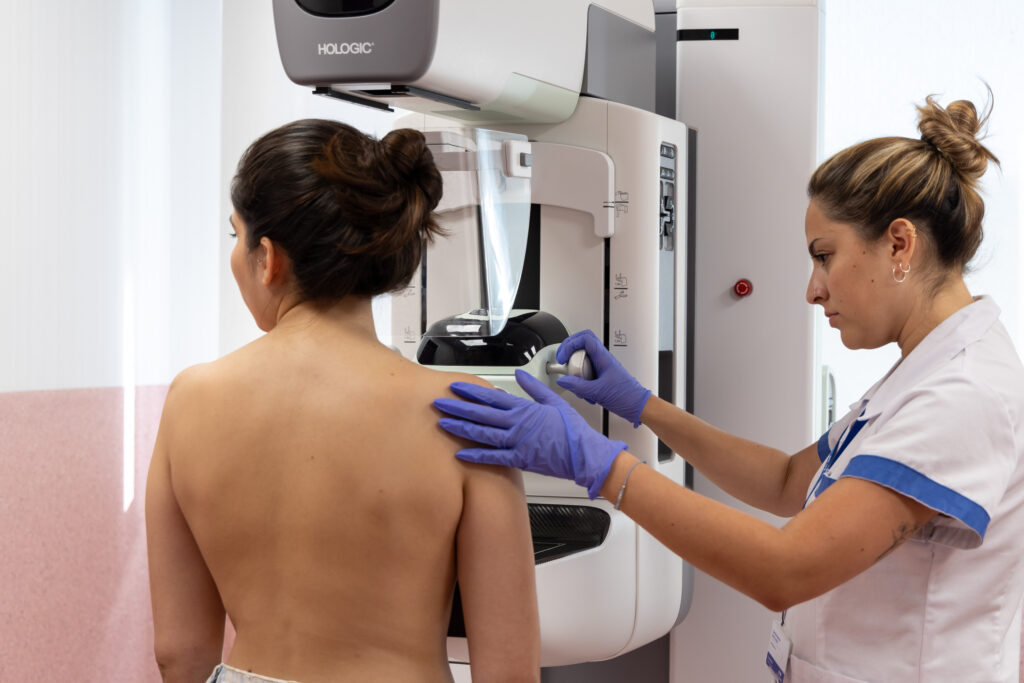Breast Wire Localization
What is Breast Wire Localization?
Breast wire localization is a procedure performed to precisely mark a lesion in the breast before surgery. The wire is a thin, flexible metal thread inserted into the breast under ultrasound or mammography guidance, allowing the surgeon to accurately locate the area to be removed.
What is this procedure used for?
Breast wire localization is used to:
- Facilitate the localization of non-palpable lesions: Allows the surgeon to find and remove lesions that cannot be felt by touch.
- Guide breast-conserving surgery: Ensures that the minimum necessary amount of healthy breast tissue is removed, preserving the breast’s shape and function.
Benefits of high technology in Breast Wire Localization
Breast wire localization is performed with ultrasound or mammography guidance. The radiologist uses the ultrasound machine or mammograph to visualize the lesion in real-time and precisely guide the wire.

How is the procedure performed?
The breast wire localization procedure consists of:
-
Preparation:
Before the procedure, your case will be reviewed by the HM Hospitals Breast Committee. In this committee, the team of radiologists and surgeons will evaluate your images and plan the best strategy for your situation.
It is essential to inform your doctor if you are taking anticoagulant medications or if you have any allergies. If surgery is scheduled for the same day, follow the fasting instructions recommended by your doctor. Additionally, we suggest wearing comfortable, easy-to-remove clothing for greater comfort.
-
During the test:
To perform the procedure, you will be asked to position yourself appropriately for the ultrasound or mammography. Before starting, the skin will be cleaned with an antiseptic to ensure hygiene. Local anesthesia will be applied to the area where the wire will be inserted to numb it and minimize discomfort.
With the help of ultrasound or mammography guidance, the radiologist will locate the lesion and insert the wire. This device releases a small “thread” of metal that remains in the breast, precisely marking the location of the lesion.Once the procedure is finished, the area will be covered with a dressing, and a control mammogram will be performed to confirm the wire’s position and help the surgeon precisely locate the lesion. The approximate duration of the procedure is 30 to 45 minutes.
-
After the test:
Follow your surgeon’s instructions regarding fasting and pre-surgical preparation. It is important to avoid strenuous physical activities before the procedure. If you notice any signs of infection, such as fever, redness, or discharge at the puncture site, inform your doctor immediately.
Recommendations for the test
It is essential that you remain still while the wire is being placed to ensure it is correctly positioned. The wire will remain in place until surgery, so it is important to follow the instructions you have been given. Do not hesitate to inform the medical team if you experience any discomfort during the test.
Are there any risks?
In general, breast wire localization is a safe, minimally invasive, and well-tolerated procedure. As with any medical procedure, there are some rare risks:
- Bleeding or hematoma: This is uncommon. A small bruise may appear at the puncture site.
- Wire displacement: In rare cases, the wire may move before surgery. It is very important to avoid sudden movements.
- Infection (very rare): it is uncommon, but there is a possibility of infection. Watch for redness, warmth, or fever in the area.
- Pain or discomfort: You may feel some pressure or discomfort in the breast after the procedure, but it is usually temporary and tolerable.
- Vasovagal reflex (rare): The procedure may cause dizziness or a vasovagal reflex. Remain calm and trust the medical team assisting you.
For your test to proceed smoothly, we ask that you arrive in advance of your scheduled time. This will allow us to complete the necessary administrative and clinical preparation.
Before the test, we will provide you with the Informed Consent form, a document with important information that you must read and sign.
If your appointment is for a Magnetic Resonance Imaging (MRI), it is crucial that you inform us about the presence of pacemakers, metallic objects, prostheses (including dental), tattoos, or medication infusion devices, such as insulin pumps.